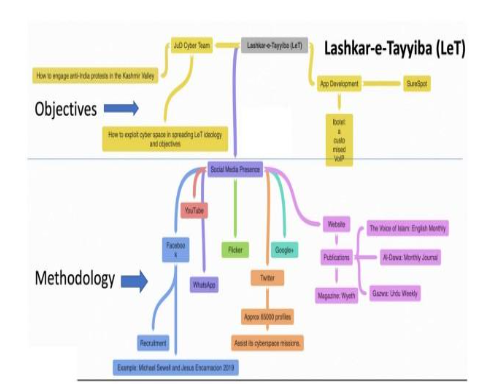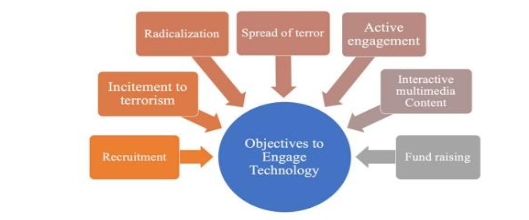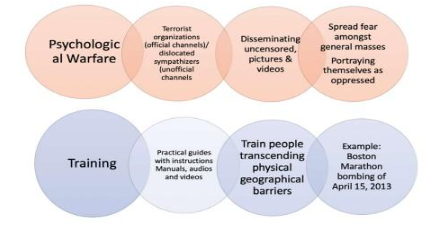Psychological warfare is defined as the deliberate use of different kinds of psychological attacks, propaganda and lies as their main means without using real violence in order to change the feelings, emotions, attitudes, and behavior of people or groups in the way we want.

It is a sort of fighting that works mainly in the psychological fields, targeting at destroying the adversaries’ spirit, decision-making and moral through martial force besides physical strength alone.
Psychological warfare can take many forms, like psychological operations (PSYOPS), disinformation campaigns, propaganda dissemination, covert influence operations, and cyber manipulation, which are all meant to influence people’s perceptions and their cognitive processes and thus achieve a strategic advantage in conflicts, wars, or political disputes. Psychological warfare has a long history with early civilizations using different forms of propaganda and intimidation to break the enemy’s morale and to show dominance.
Complications are such as what is described by Sun Tzu, the I Chinese military expert in his ancient work “The Art of War”, that he saw the significance of deception and manipulation of the mind in the military operations. Likewise, the ancient Greek and Roman empires resorted to propaganda, symbols and set an example to their enemies by being fierce and fearful to instill the required emotions.
While in the medieval and Renaissance era, psychological warfare was still a major part of military and political conflicts. The Crusades had, among others, introduced the use of propaganda and religious beliefs in the morale boost of the Christians and in the hatred of the Muslims towards their enemies. In the same way, during the Hundred Years’ War, the English and French troops deliberately employed propaganda and psychological tactics against enemies’ morale and favored their own morale.
The development of warfare in the 20th century had led to a huge increase in the use of psychological warfare techniques. In World War I, both of the allied and central powers adopted the same media tools: posters, leaflets and radio into their propaganda campaign that aim at both persuasion and convincing people to enlist and at spreading their propaganda and hence diminishing their enemies support and morality. Illustrations of this case will be mentioned with examples such as the British “Lord Kitchener Wants You” poster and the German leaflets dispensed over enemy lines exhorting them to surrender. In World War II, psychological warfare was the main instrument of change in the course of the war.
Nazi Germany resorted to highly innovative and effective methods of propaganda through various mediums such as broadcast radio, films, magazines and newspapers to instill the ideology of the Third Reich in the population and strive to portray all perceived enemies as the Jews and the Allied powers. Effective propaganda is what makes Joseph Goebbel an infamous propaganda minister who maneuvered intricate efforts to control the minds and attitudes of the German people.
Akin to these, the Allies, for instance, the USA and Britain, embarked on psychological warfare operations through which they fought the German propaganda and helped to build morale amongst their own troops as well as at the civilian front. This was done using propaganda films, for example, the “Why We Fight” series by Frank Capra, which was made to educate the American soldiers about the reasons for the war and to instill support for the Allied cause.
This period saw a new stage of psychological warfare. On the one hand, we see the Western democracies fighting against the USSR, and on the other hand, we see the ideological struggle evolving. On both sides, the propaganda campaigns, covert activities, and information dissemination were conducted to have the targeted audience side with the present group and withdraw the support from the competitors. For instance, the CIA’s secret assistance to the anti-communist movements in Eastern Europe and the Soviet Union, the distribution of the propaganda materials promoting the advantages of communism were some of the typical examples.
Psychological warfare in this digital age has advanced and improved in sync with technology and communication innovations. States, terrorist groups and non-state elements are using media on social platforms, cyber warfare, dis-informational transparency to have propaganda, recruit supporters and destabilize their hostile actors. Russia’s manipulation of social media bots and fake news to influence the outcome of elections and create tension in Western democracies is a good example, while the Islamic State’s online propaganda videos and recruiting initiatives aimed at radicalizing people and inciting violence are other examples.
As the psychological warfare is very integral in the modern tactics, easy to use is prophecy. It is about a kind of means of distribution of the message, which is mostly can create a wrong image and be used for pursuing the special aim. Propaganda is a way of influencing people’s views and it can be seen in the state-sponsored media, the leaflets dropped over enemy territory and the social media campaigns which are thought of as ways of spreading disinformation and shaping the narratives.
As for the Second World War, the allies, as well as the Axis forces, exploited propaganda to the full. It was made to inspire morale and show hatred towards the enemy. BBC remained as the hope for occupied European nations through its own radio’s service and the Nazis used propaganda films and posters to promote Aryan superiority.
Deception techniques include purposefully misleading the enemy or hiding one’s real motives to obtain the upper hand in a certain area. In the military, it can display itself in different manners, such as feints, camouflage, deception, or misinformation intending to confuse or confuse the enemy. The special case of the deception tactics of Operation Fortitude during World War II showcases this. The Allies made up fake military units, used inflatable tanks and airplanes, and leaked false information about the location of the D-Day invasion to make the Germans believe the Allies were planning to invade from a different place.
PSYOPs is executed with the application of psychological measures that aim to change the way people think, feel and act towards a hostile population. For example, such enterprises usually implement a system of ritual use of propaganda, information confusion and pinpointed communication for moving narrowly foreseen steps, such as giving a blow to enemy ego, mobilization of supporters and discrediting authority of the enemy. In the Vietnam War, the US had a huge program of PSYOPs, which were aimed at demoralizing the North Vietnamese forces and winning the hearts and minds of the Vietnamese people.
Among the measures taken were the leaflet distribution, radio broadcasts, and loudspeaker announcements calling on the enemy troops to defect to the South and for the civilians to help the South Vietnamese government. Cyber warfare is a type of computer-based attack aimed at disrupting, sabotaging, or manipulating the information systems of an adversary. Such activities include hacking the networks, spreading malware, conducting disinformation campaigns as well as cyber espionage to either be used for gathering intelligence or to cause confusion.
The last few years have brought accusations that Russia is using cyber warfare as tactics to subvert the domestic affairs of other states with examples including the US and European nations. The Russian government is accused of being behind hacking attacks on political parties, spreading false information through social media, and trying to disrupt elections in Western democracies.
Cultural skirmishes mean to capitalize on cultural, faith, or ethnic descent of the target community to drain their solidarity and cause disharmony. This can be through polarizing narratives, use of historical animosities, or sponsorship of groups who are later used to do proxy interests. In the Middle East, the extremist groups have exploited cultural warfare tactics to gain new followers and to encourage violence.
The ISIS, exploiting the sectarian fault lines, used to identify with the religious identity in order to destabilize the governments, undermine the regional stability and form an imagined caliphate. In 2017, he made a statement in the form of a newspaper advertisement claiming that performing jihad with the help of the internet and smartphones was also possible. They have used social media to influence the minds of many young ones.

The psychological war is so broad as to comprise a number of the methods that are intended to change perceptions and behavior of adversaries, friends, and neutral parties. Either through propaganda, trickery, psychological operations, cyber warfare, or cultural manipulation, psychological warfare is a process of shaping narratives, destroying opponents, and achieving strategic goals without any use of force. The following chart can explain how militant organizations target people.

Moreover, educational resources such as practical guidelines accompanied by detailed explanations and instructions are accessible in various formats including handbooks, audios, recorders, and videos at no cost. This particular facet holds great significance as it enables radical groups to facilitate the transcendence of physical boundaries. A case in point is the tragic incident of the Boston Marathon bombing that transpired on April 15, 2013. The youthful perpetrators had acquired the knowledge of constructing pressure-cooker bombs by following the instructions provided in Al-Qaeda’s online publication.

PSYOPS Warfare in U.S. – China Rivalry
Moving forward, both the United States and China engage in propaganda and narrative shaping to promote their respective worldviews and to influence global perceptions. Often the US gives an accent to democracy, human rights, and freedom of expression, highlighting itself as a champion of the liberal ideas. On the other hand, China stresses the ideas of ‘socialism with Chinese characteristics’, ‘national revival’, ‘Chinese dream’ among others as a way of claiming its own model of development and governance.
Propaganda campaigns are meant to enhance the national support, join the international allies, and denigrate the rival’s ideology and governance system. Intrusion and misinformation campaigns are omnipresent in the US-China quarrel, and both sides combat with information warfare, using it to devalue each other’s information and propagate their narratives.
Ranging from the dissemination of misleading data to counteract violations of human rights, muting dissident voices, to projecting an illogical and atrocious image of the Chinese government, China has been accused of spreading false news. Just like that, the United States has also come up with measures to show the Chinese disinformation mainly about the origin of the COVID-19 and China’s human rights record.
These operations target the leading side and are designed to discredit their messaging and befuddle the opponents’ public. Psychological warfare between the United States and China on the cyber front is critical, where both sides launch and defend their offensive and defensive cyber operations to gain a strategic upper hand. Chinese cyber espionage focuses on the American government agencies, defense contractors, and critical infrastructure, with the aim of stealing sensitive information and reducing the American technological superiority.
Matching such efforts, the USA performs cyber operations for disrupting Chinese espionage, protecting its own networks and deterring their next hacking attempts. Hacking, data breaching, and online propaganda are employed to distort narratives and affect the decision making processes, however. Social media platforms are the grounds for the psychological warfare in the USA-China rivalry, where both parties use sophisticated influence operations to manipulate the online discourse and shape the public opinion.
The Chinese government employs state-controlled media, and paid influencers to chase propaganda and suppress the opposition messages, while the US utilizes a vast presence in social media to denounce Chinese propaganda and promote the democratic ideas. These influence operations seek to control global opinions, undermine the opponents and gain the support of each side for their strategic objectives. Cultural diplomacy and soft power expansion are essential elements of China-USA psychological warfare, as both sides seek to amplify their global influence by organizing cultural exchanges, educational initiatives, and media outreach.
The United States actively fosters the cultural exports of Hollywood movies, popular music and social media brands to demonstrate and expand upon US values and ideologies. On the contrary, China spends a lot of money in cultural diplomacy programs like the Confucius Institutes and the Belt and Road Initiative to spread its cultural influence and promote its political interests. These initiatives are directed towards shaping international images, creating positive relations and outdrawing every country’s sphere of influence.
Psychological warfare in the US-China rivalry affects highly the dynamics of bilateral relations, regional security, and worldwide peace in general. It worsens mistrust, intensifies conflict, and strengthens ideological differences, thus making diplomacy, conflict resolution, and cooperation difficult. Worse still, disinformation and misinformation becomes a direct threat to many institutions, unity of society, and democratic norms. In the digital era where information travels from one end to another in a blink of an eye using social media as the means of spreading the information, psychological warfare shows itself as a complicated and rapidly-evolving problem for the policy makers, intelligence forces and civil society organizations at large.
The case of India’s psychological warfare towards Pakistan: motifs and implications
India and Pakistan have an old story about conflict and dispute, with the most brutal battles, border fights as well as proxy wars. Aside from the traditional military tactics, these two countries have also carried out psychological warfare to influence each other’s morale, public opinion, and gain strategic advantage.
The long standing tension between India and Pakistan was sparked by the colonial secession of British India in 1947 leading to the forming of independent two nations. After that, these two countries have been in numerous wars and have also been in different forms of conflicts such as insurgency, terrorism, and propaganda campaigns. The controversy around the area of Kashmir as one of the main drivers of the Indo-Pakistani conflicts has been lying at the root for many years. India employs psychological warfare techniques in gauging opinions about the conflict of Kashmir at home and abroad. Among these is the effort to characterize Pakistan as the main supporter of terrorism in the region and to justify its military presence in Indian-administered Kashmir as a counter-terrorism measure.
India sought its reshape of Pakistan’s image through their media and information system by showing Pakistan as a destabilizing country in the region. The Indian media has faced the charge of vicegerent strategy and fake news to blacken Pakistan and escalate India’s armed involvement as cross-border raids and air strikes, among others.
India has tried to diplomatically isolate Pakistan internationally by showing the world how Pakistan is supporting the terrorist groups and how it is not controlling the cross-border terrorism. India’s foreign policy, especially at forums like the UN Security Council, is designed to secure the necessary international backing for accusations it makes against Pakistan being a terrorist sponsoring state.
Today, cyber warfare has developed itself into a psychological weapon that has been used for campaigns. India has been allegedly conducting cyber-attacks against Pakistani government websites, military networks, and critical infrastructure, in order to disturb communication channels, gather intelligence, and create confusion among Pakistani authorities.
Now Pakistan has spent in making public diplomacy efforts so as to strengthen its soft power and hence projecting a more favorable image of itself all over the world. Such activities will include cultural exchanges, educational programs, as well as outreach initiatives that present Indian democratic ideals, economic development, and cultural diversity against the backdrop of Pakistan’s instability and extremism. India’s strategic messages against Pakistan often stress the subjects of national unity, resilience, and perseverance in the face of external threats.
One of the common themes in the public speeches by the Indian leaders and officials of military and policy making is the unambiguous display of the military might to deter Pakistan from acting to threaten Indian sovereignty as perceived by the Indian government. One of the most commonly alleged points against India is that she has been supporting the insurgent groups and separatist movements in Pakistan as part of her broader strategy to weaken Pakistan internally and its integrity from the territorial point of view.
These secret operations, carried out through the proxies and hidden channels, are designed to take advantage of the internal cracks and to create unrest in Pakistan. In response to the tragic terror strike on Indian security forces in Pulwama in February 2019, India conducted an airstrike at apparent terrorist camps in Balakot, Pakistan. The Indian government’s message around the airstrikes was that they were a decisive reaction to Pakistani-sponsored terrorism and that they were a sign of India’s determination to protect itself from external threats.
The veracity of information put out by Indian media institutions is often questioned as being inaccurate or misguided to manipulate public understanding of Pakistan. In another context, the media may also have represented the Mumbai 2008 incident as a direct aggression by Pakistan against India leading to straining of the bilateral relationships between the two countries. India has been actively lobbying international partners to brand Pakistan-based militant groups as terrorist organizations and put sanctions on individuals and entities with alleged connections to terrorism.
India’s diplomatic policy aimed to encircle Pakistan internationally and eventually to consolidate the community of nations against Pakistan’s apparent cooperation in sponsoring terrorism. India’s psychological warfare against Pakistan contains multidisciplinary methods to affect minds, create storylines, and achieve strategic initiative in Indo-Pakistan rivalry. India’s intentions may be justified by the security concerns, but at the same time, they are also likely to escalate the tensions and increase the mistrust between the two nuclear-armed neighbors. Thence, pushing de-escalation of conflicts, dialogue, and the addressing of grievances would ensure the entrenchment of long lasting peace and stability in the region.
Countering psychological warfare
Countermeasures against psychological warfare are what we need to protect ourselves against psychological war-meddling and caring for mental and emotional health of individuals and societies as well. These countermeasures cover a wide spectrum of strategies that are designed to boost resilience, stimulate critical thinking, resist propaganda and strengthen psychological defenses. Next, I will enlighten the major psychosocial countermeasures. Educating the people and informing them is what is crucial in the fight against psychological warfare.
Through the education of the public concerning the tactics, techniques, and strategies used in psychological warfare, people will be able to become more of a critical consumer of information. Training critical thinking, media literacy, and questioning of unreliable or biased media sources are among the tools that can empower an individual resist manipulation and propaganda. Indeed, psychological warfare can be fought by the strength of truthfulness and openness. The governments, institutions, and organizations must do their best to deliver the accurate, reliable, and transparent information to the public. Through transparency, candor, and admittance of their activities, policy, and purposes, they can earn credibility and trust, thus declining the abilities of opponents to diffuse false information and create division.
Coming up with counter propaganda campaigns allows us to neutralize and outmaneuver the enemy’s propaganda and disinformation. These campaigns are about spreading true and convincing messages to overcome the false stories and fight against the misinformation. The exploitation of different media avenues, including social media, traditional media, and grassroots initiatives, can be employed in counter-propaganda approaches to affect public perceptions and offset the magnitude of rival actors.
Psychological warfare resistance training programs would help people and communities acquire against mental warfare tactics. These programs are designed to teach coping techniques, stress management skills, and resilience-building exercises to individuals who will be able to withstand the psychological manipulation and keep their mental and emotional balance in the face of adversity. Due to the spread of online propaganda and disinformation dissemination campaigns, cyber security obstacles are still important to fight warfare in the electronic environment. Governments, organizations, and individuals should put strong cyber-security measures in place to counter any cyber-attacks, information manipulation, and the acquisition of our data by hostile groups.
Cyber-security field requires the accomplishment of such tasks as network security, data protection and information security awareness. Psychological operations frequently exceed the territory of countries, which makes the international partnerships a leverage for countering their effects. The cooperation among governments, intelligence agencies, and international organizations can enable the exchange of intelligence, resources, and best practices in the fight against psychological warfare. Through collaboration nation states can create connections which will make everyone stronger in the face of psywar attacks.
As for the development of critical thinking and media literacy is a fundamental puzzle for survival in the information area in the digital time. Through the enhancement of critical thinking skills and the instruction of people how to critically assess information, the societies will be able to give people the power to detect and refuse misinformation and propaganda. Media literacy programs can enable people to become more savvy information consumers and less easily influenced by psychological trick play or manipulation. Holding ethics and accountability of psychological operations as a top priority would do good in maintaining legitimacy and credibility. Governments and organizations working in the field of psychological warfare should follow the ethical rules and international laws regarding the use of propaganda and manipulation techniques. Failure of the standards to be complied with must be investigated and tackled in order to counter abuse and promote accountability.
Author: Rana Danish Nisar – Independent international analyst of security, defense, military, contemporary warfare and digital-international relations.
(The views expressed in this article belong only to the author and do not necessarily reflect the views of World Geostrategic Insights)
Image Source: Forbes







